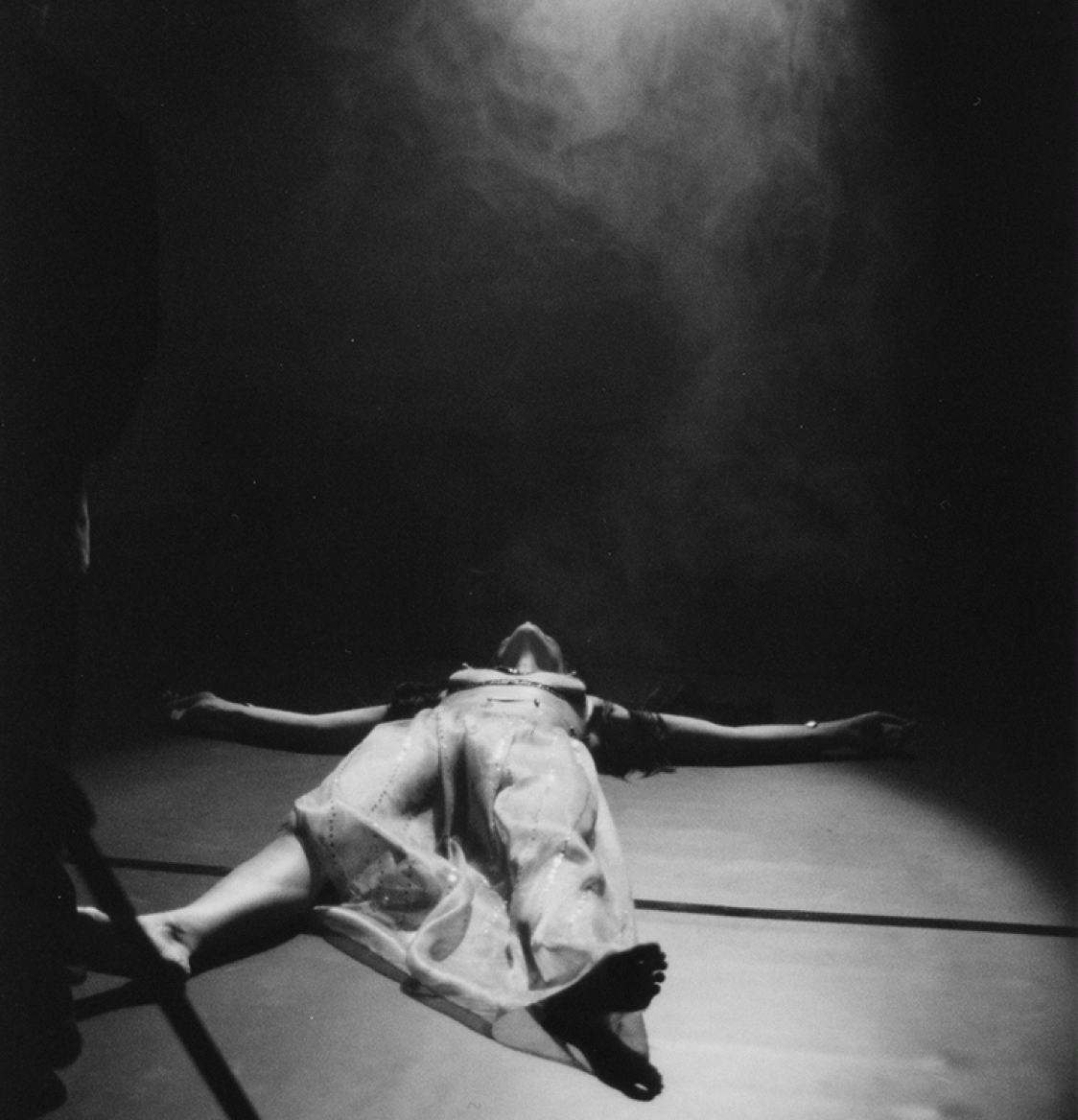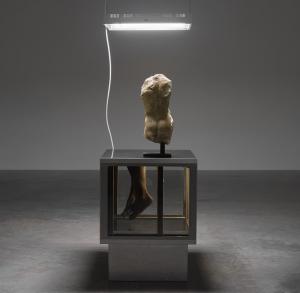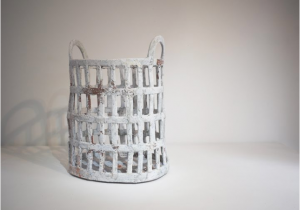ICON, SUBLIMATION AND TRANSFERENCE
THE DARK LADY: CYCLE OF MYSTERIES (work-in-progress)
Company: Theatre of All Possibilities
Director: Kathelin Gray
Venue: The October Gallery
Date: August 9, 2002
Reviewed by Ishmael Annobil
There is that sense of incredulity associated with watching Theatre Of All Possibilities make one of their phenomenal quakes across the artistic strata. Then there’s the dawning – that steady unfolding of raw nature norm. The Dark lady was the epitome of that process. It was also a patent watershed for director Kathelin Gray and the group, who are allied to a polymath consciousness and are, therefore, gainful and manifold in their approach to theatre. Symbolic theatre, that is.
Here The Dark lady, who reigns across the latent faith-scapes of all cultures, is extruded through history for contemporary alignment. And we are for once faced with all her transfigurations, as Black Madonna, Mary Magdalene, Oshun, Leimeya, River Goddess, inter alia. This is done through language that pivots on a powerful dance dynamic, at once primeval and dreamlike. The polemical context is modern, the dramatic episodes are totemic, and the visual articulation acute and new.
There are six episodes in all (Ecstasy, Illusion, Story/Dream, Luminosity, Bardo and Transference of Consciousness) and twenty-one scenes, each with a well-defined parabolic aspect that weaves neatly, nevertheless, into the odyssey proper. A bard, Dub John (played by poet Aidan Andrew Dun), bridges the episodes with a contrapuntal declamation weighted with sheer modern urgency, forcing a modernistic social reckoning, highlighting the spectre of an ancient treachery still roaming the land, forcing the mind to traverse meanings, dark meanings (race tension and systemic tyranny included), while establishing solid redoubts for dissent and spiritualism.
This sagacious piece of theatre opens without sanctimony. The musicians walk in, and cross over into a blue haze, where they are poised for a moment as though they were tableau vivant. We soon hear the stroking hum and shimmering of tarantella (by New York based Alessandra Belloni). Black Veils, a heaving foursome, sails in with the aura of a cavalcade of agonies. Rising steadily to these dark personages is a near-truculent tarantella rhythm, enticing an initiate to step out of the fold to decant (Exorcism). This person, initially presumed feminine, writhes forth in a spasmic trance, ripping off seven layers of clothes (or veils) till we are faced with a bare man (Carlos Fernandez), emblazoned in corporeal symbols of religion (Christianity, Judaism, Islam and Buddhism).
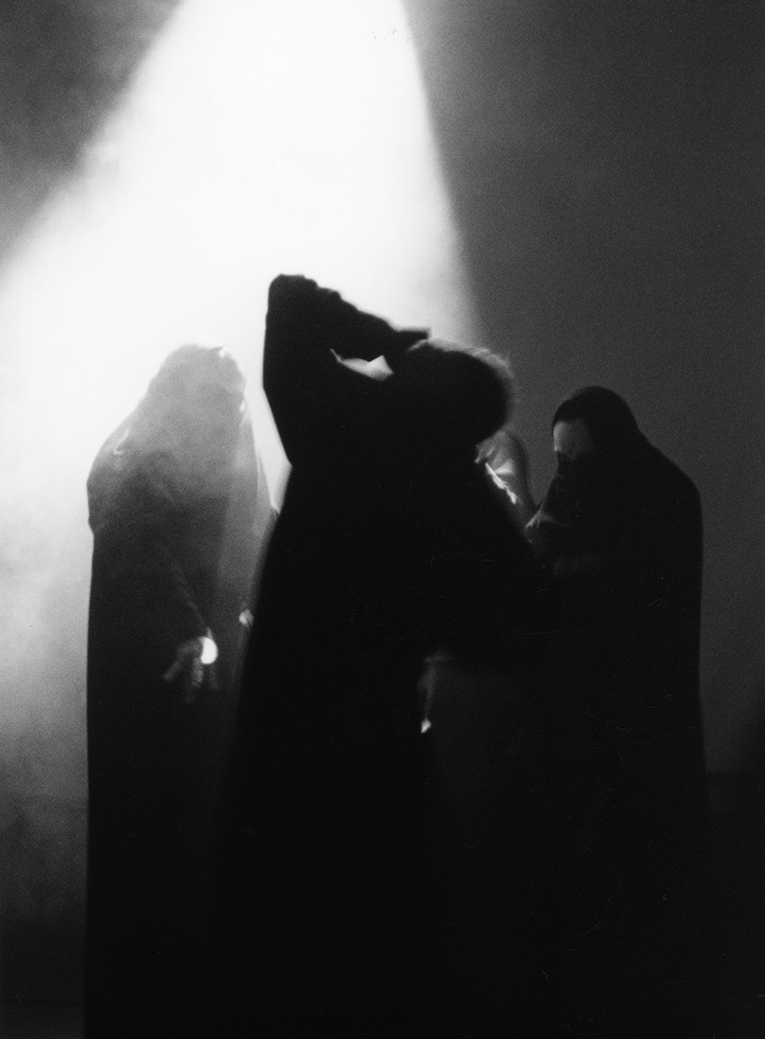
Thus exposed, our initiate steps into a fevered dance to exorcise his machismo, and this dance evolves through ancient stations of choreographic invocation; from the eruptive verve of a dervish (at times poignantly foetal in his submissions), to an enflamed flamenco spirit. Essentially, this leads him to the magical point of synoecism, or the nebulous state of being, where he faces a core female realism, or even the clear dichotomy of his male and female parts, and therefore sentience, before being able to raise his head again as a man.
Significantly, while serving this primal duty, this choreographic wonder still manages to feature a studious but wispy tableau of cross-cultural dance forms, morphing and overlapping seamlessly. Indeed, the transitions are brilliantly elusive, to say the least, not to mention the awe-inspiring vigour of Carlos Fernandez. If critical analysis be made to bear, this choreography is exemplary in the director’s ability to delay the performer’s innate Latin idiom for the sake of historical logic, before releasing it. Thoroughly trounced by his rigorous ‘metamorphosis’, our initiate finishes with his head thrown back as though he were a sacrificial lamb; desolate, as if dropped down by the ether.
Machismo seen to, we explore other parts of the legend, while bearing in mind the piece’s overarching context of catastrophic love turned global cataclysm, ecological devastation, and the rediscovery of the sacred (through neo-Freudian, sex-centric inquiry, but leading this time to an auspicious awareness of our evolutionary and creative prowess).
So then, Obsidian (played by Kathelin Gray): An embodiment of the mythic rock that fell to earth to beget humans, this personage presents instant, dark tension. Balanced as it were on the quandary of pro-genesis, it must first establish its own identity, or even find it. The personification loses herself to the quandary, dredging the darkness, unfolding even so with the fury of a hatching egg. Her feet are up and, from her proverbial supine position, rolls about the place. She soon establishes a repetitive movement, the meaning of which is the repetition itself. Yet there is confusion at the end of each roll, confusion about place, because the dialectics lacks a drawn line. Her introspection leads nowhere really, because the answer lies in that very state of stasis: She is the mystery (“How can mystery sense itself?” asks Gray).
In essence, she is absolute certainty, which is disarmingly innocent and ancient at the same time. Obsidian is Kathelin Gray at her callisthenic best. She invests this image with a sinewy energy, whose tempestuous self-doubt and search are apparent with every turn. Her grimaces, alarmed as if shocked by her ill-suited temporal awareness, draw our pathos. Nevertheless, it also inspires a belief in her tenacity and imminent victory. She does win, but with a stupefied expression framed by light – the face of self-sacrifice. Obsidian is scored live by koto virtuoso Chieko Mori.

Things move on into the sphere of political intrigue with the remarkable Valse Of Illusion (Illusion / episode 2), a mini neo-Medicean masque ball, peopled by androgynous revellers marked by their sartorial grandeur and the absence of necks and faces – just hats. Thus disguised, they present an arcane waltz, characterised by emblematic exchanges, curtsies and handshakes, all brilliantly emphasised in the manner of burlesque. This is secret society wielding faceless power. As Kathelin Gray puts it, “identity disguised is power disguised.” And there’s the resultant androgyny, which offers perfect fostering grounds for cryptography and obscurantism, even nonsensical dogma.
We are put in mind of the kind of befuddling milieu Orpheus attempted to wrench essence, solace, or even closure, from – ditto his hapless modern counterparts. The absolute nature of this insidious power system is terrifying, when viewed against the dandified appearance of these figures. For you know for sure that this conclave of dandies is hell-bent on doing major political, economic and psychological nastiness, though you can’t prove it. The choreography is refreshingly delicate and light-footed, highlighted by aquiline head movements and graceful, stockinged legwork in the subdued lighting, Even so, it creates a sense of a melee suffused with its own sublime tensions. And that is the key to this horror – cloak and dagger. Music is by LSD.
Hecte/Innana; Man in Top Hat, another remarkable scene from Illusion, reverts us to the dance of seven veils, but from the female point of view. Here the protagonist (played by Savannah Chevrier) starts off as a goddess who slowly strips off her vanities (in the form of seven veils) in order to reach her dark level, akin to death. Hers is a feverish dance, therefore, observed all the while by a young boy (played by LSD) who affects maturity with a top hat. He is her animus, and he happens to be struggling with puberty, which causes him to speculate on her as his object of desire. A dualism played out in two separate bodies. So, as she contorts to reconcile the agonising kicks of her core ‘diametrics’, he circles her like a halo.
The dance here enacted is highly charged, with the distress of the protagonist rising steadily to the top, till her own trampling and squirming quest for a purge commandeers her senses into a self-hypnotic blur. So then she sees nothing outside herself, till she topples with near orgasmic fury into her dark level. Then her animus relents to pathos and merges with her. This the director characterises as “holding your breath and coming out to take your first breath.” This is physical theatre at its most refined. For even when dynamic norms are at play, there is a systematic articulation, moving the audience, as though through a yarn, to a crescendo (itself unpredictable). The scene finishes with the protagonist staring into the darkness (into mortality).
After that upheaval, we are offered a brief moment for breath by the piquant Lady of the Waters, a beautifully lit scene, glazed with superb Mylar-generated wateriness. A Brazilian chant (by Alessandra Belloni) sweeps through this magical milieu. Two nymph-like beings (played by Natasha Lyanko and Susanna Bailera) are perched daintily as though on earth’s edge, purifying our ancient waters. One listens in a conch then pours water from it into our ancient waterways , obviously those we have polluted, to cleanse them. Her companion attends her with golden fronds. Their slow balletic movements against the glint of lights and the finely cadenced incantation, is very memorable. It is a very well crafted scene that achieves its majestic aura with little effort. And, given the celestial nature of the entities at work for us, we are forced to imagine the enormity of our ways.
While we muse over that propitious purge, we are surprised by the presence of the Tree Deva (episode 3 - Story/Dream). She (played by Chili Hawes) is merged with a wood sculpture (by El Anatsui), through which she peers at us. Her demeanour here is of a woken deity, as she spies on our travails to gauge the palliation we require. That sussed, she uncoils from her gnarled, elemental cocoon, limbering up to the rhythm of tarantella, till she slowly transforms into a choreographic ‘fireball’. Hers is the Dance of the Protectress. And she proves it beyond doubt.
This lithe figure of a middle-aged, beautiful, intelligent, benign, pure and serene mother smiles at us, while negotiating very complex steps, sometimes reminiscent of West African fetish dance, sometimes shamanistic Aztec, Inca, and even Native North American idioms. This dance, at once graceful and extremely intricate, wakes in you a wide-ranging sense of historical moments, creation, sacrifice, ritual, for she has obviously made many spiritual crossings to be with you. So her all-seeing magnificence unfurls like a sacramental scroll before your eyes, kneading your narrowed senses to open up to receive the oblations she bears you. She is pacifying the elements that begot and sustain you. You feel her walk on water. You feel her breath in your veins as she toils over you. So you feel like rising from my seat to do your primal scream then prostrate yourself before this goddess. Yet her coup de grace renders calmness. She blows at us and into the four corners of the globe, to expunge global devastation, and then she is gone. This electrifying dance is the apotheosis of art itself.
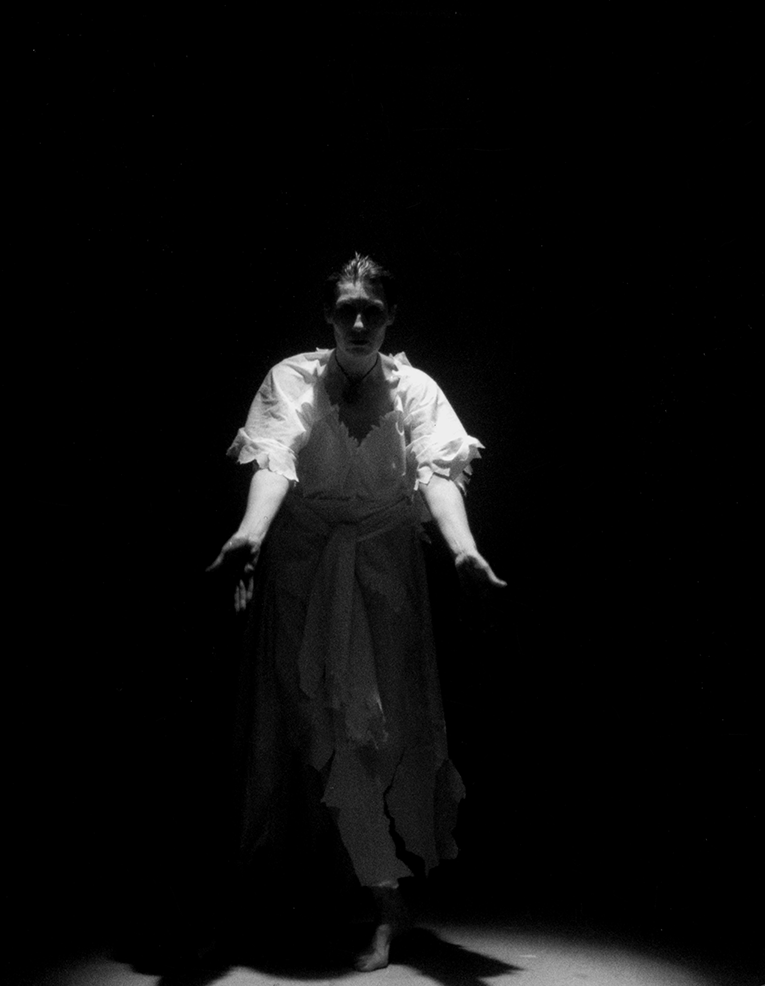
The theme of ‘sur-substantial’ beings is taken into an even more surreal realm with the Crone Spider (Luminosity/episode 4). The underling narrative is about a goddess who removes her seven veils and gets lost in the wilderness, but manages to restore her veils to re-emerge and wreak revenge. Her alter egos are personages like Mary Magdalene and Poetess Komachi (and it must be added, Nijinski), who had to opt out of greater society and lived wild till ripe old age. Played by Miriam Shaffenshausen, the Crone re-emerges from the wilderness with a haunting wail, and heaves forward as though paddling through a swamp, with the bearing of an imp or mischievous faun, till we are within earshot of her tale. She utters it in poignant non-language, as though she speaks with birds.
She points to the unseen object of her address (our eyes follow her finger), and she coos and mutters her infantile diction at it. All the while, she keeps trudging, her Nordic head tipping from side to side like a faun’s, her eyes glistening with illogical serenity, as if she presumes our comprehension. And slowly we, too, are convinced of our comprehension, so we abide her, and soon we seem to understand her. It is lucid grammar after all, it is dense with meaning and, though this crone seems self-sufficiently happy, we start to discern a deep pain emerging from her soul. She seems to speak from the little fertile space left in her damaged mind. And this atrophied mind seduces us with its dredging wisdom, though we fear imminent censure. She is too ethereal; we want to turn away, but are ringed in by her lucidity. She tells of the coldness of humankind, the crushing pain of alienation, of the darkening of the superego. Yet she leaves us alone in the end. Job done. The director tells me the paradigm is of “an old woman who has been through it all and doesn’t give a damn”. Miriam Shaffenshausen dignified this indifference, gloriously.
From then on the narrative veers off at a tangent into Hades: Inferno Tableau (episode 4 –Bardo). A damsel (played by Chieko Mori) descends into the hell of her own being (virginal and also demonic), and all her many forms. These forms, personified by groping ghosts, are also her minions, but they are consuming her. She must get away from them. She trashes about the place, tiptoeing, hopping, and yelping whenever their probing fingers get too near. Chieko Mori’s music accompanies this grim ballet brilliantly.
In retrospect, however, one suspects that this Kurosawa inspired sequence will benefit from more of Gray’s inimitable articulation, though it still offers a legitimate launch pad for Fan and Flame (Transference of Consciousness /episode 6), which sees Kathelin Gray partnering Chieko Mori in a ritual dance signifying the eternal, fire of creation/destruction paradox. The emphasis is on the unconditional acceptance of this process (the readjustments to change and upheaval of a creative relationship), and the resulting facility for creating life, soul and art with it. This is meticulously realised through the ever-interchanging matrices of concomitant sexuality, divergent emotion – specifically, the things that go wrong between the sexes – and resolution of tension.
Yet, in this two-way discourse, our characters are poised to brazen through all the unpleasant vicissitudes of sensual amalgamation, while aiming all the same for a workable constant, however transient, however catastrophic. The background to this encounter is, aptly, a gloriously raging fire effect. Enter subject one (Chieko Mori) with hand fan, quickly, high stepping, fanning and prancing, “looking like something looking for somewhere to alight”. She goes out and back again, establishing instant irrationality. Enter subject two (representing the liquid state of obsidian), a bellicose combatant, thrusting her fan at an imaginary being, then at subject one, and then affecting hara-kiri. From here on we witness a titanic tussle, which descends and ascends the human scale with mercurial ease, at once murderous and harmonious, till it ends with the subjects side by side, hiding their faces behind fluttering fans – Is it post-coital coyness or post-animalism? I daresay it’s both things. This haunting performance harks back to some of TAP’s earlier works, most notably, Chronorama (1 and 2), and Six Charms in Time. I would gladly pay a mulct to see a single showcase of all the instances of this electric technique. Music is by LSD.
In the end there has to be definitive closure. Having resurfaced from their multi-layered inner journeys, and having benefited from the oracle, all our subjects are obliged to render a rigorous group expiation. We encounter the full force of Tarantella, chaperoned centre stage by the surefooted Alessandro Belloni. This time her rhythm assumes it full polyphonic attributes, conjuring up a bristling sense of cloistered meditation (full-blooded phantasm). The dance form is, essentially, a Charlston with a Moorish edge around a white sheet with ribbons on its four corners, and strewn with cards of The Madonna.
The supplicants dance around this sacral sheet, lashing it with red ribbons, taking turns to assume the supine position on it with their legs up. (And here I venture into symbolic anatomy – this posture brings the supplicants’ sacrum in touch with the ground, thus opening them up sufficiently for the oracle to imbue them.) The ecstatic fervour of this ritual dance is authentic and, barring the absence of gyrations, it recalls the tigali of Ga fetish priests (Ghana). The supplicants, in their euphoric trance around the sacral cloth, seem to carry our collective paean with them. But even as it progresses, we see the modesty of humankind vis-à-vis the Deity. Nevertheless, the bard rises from the midst of this Tarantella and delivers the denouement.
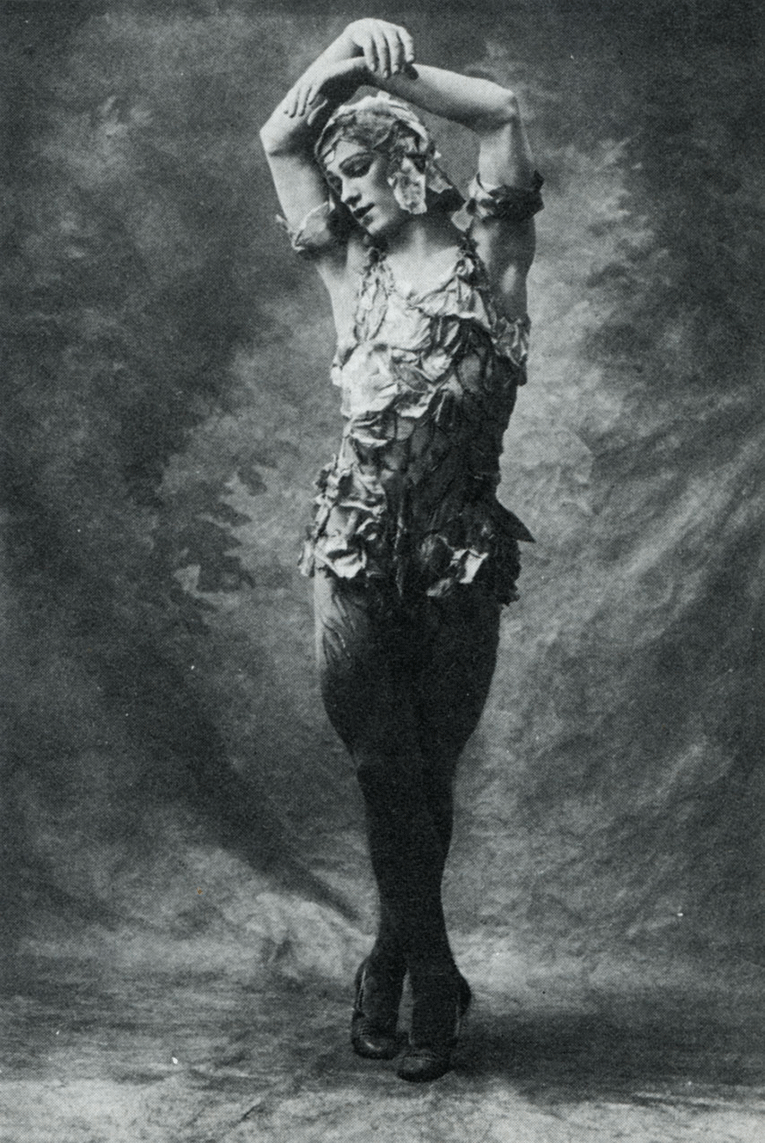
The Dark lady is a veritable masterpiece – not only in Avant Garde terms, but also in terms of that higher human quest for truer truths. It must be recalled alongside Nijinski’s groundbreaking moments, for it reflects aspects of his vision honourably. This is the real theatre; it cannot be finite.
Photo Credits:
1. Hecte/Innana; Man in Top Hat, from Dark Lady. © Ishmael Annobil
2. Dance of Seven Veils, Dark Lady. © Ishmael Annobil
3. Dance of Seven Veils, from Dark Lady. © Ishmael Annobil
4. Miriam Shaffenshausen as The Crone, from Dark Lady. © Ishmael Annobil
5. Vaslav Nijinski, © Wikipedia


